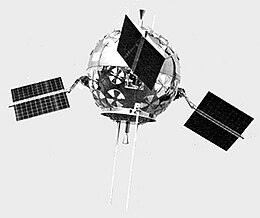Spacecraft design
Pioneer P-3 was a 1-meter diameter sphere with a propulsion system mounted on the bottom giving a total length of 1.4 meters. The mass of the structure and aluminum alloy shell was 25.3 kg and the propulsion units 88.4 kg. Four solar panels, each 60 x 60 cm and containing 2200 solar cells in 22 100-cell nodules, extended from the sides of the spherical shell in a "paddle-wheel" configuration with a total span of about 2.7 meters. The solar panels charged chemical batteries. Inside the shell, a large spherical hydrazine tank made up most of the volume, topped by two smaller spherical nitrogen tanks and a 90 N injection rocket to slow the spacecraft down to go into lunar orbit, which was designed to be capable of firing twice during the mission. Attached to the bottom of the sphere was a 90 N vernier rocket for mid-course propulsion and lunar orbit maneuvers which could be fired four times. This space engine was designed and built under contract with NASA by the Space Technology Laboratories (STL) of TRW.
Around the upper hemisphere of the hydrazine tank was a ring-shaped instrument platform which held the batteries in two packs, two 5 W UHF transmitters and diplexers, logic modules for scientific instruments, two command receivers, decoders, a buffer/amplifier, three converters, a telebit, a command box, and most of the scientific instruments. Two dipole UHF antennas protruded from the top of the sphere on either side of the injection rocket nozzle. Two dipole UHF antennas and a long VLF antenna protruded from the bottom of the sphere.
Thermal control was planned to be achieved by a large number of small "propeller blade" devices on the surface of the sphere. The blades themselves were made of reflective material and consist of four vanes that were flush against the surface, covering a black heat-absorbing pattern painted on the sphere. A thermally sensitive coil was attached to the blades in such a way that low temperatures within the satellite would cause the coil to contract and rotate the blades and expose the heat-absorbing surface, and high temperatures would cause the blades to cover the black patterns. Square heat-sink units were also mounted on the surface of the sphere to help dissipate heat from the interior.

Mariner 2, an American space probe to Venus, was the first robotic space probe to report successfully from a planetary encounter. The first successful spacecraft in the NASA Mariner program, it was a simplified version of the Block I spacecraft of the Ranger program and an exact copy of Mariner 1. The missions of the Mariner 1 and 2 spacecraft are sometimes known as the Mariner R missions. Original plans called for the probes to be launched on the Atlas-Centaur, but serious developmental problems with that vehicle forced a switch to the much smaller Agena B second stage. As such, the design of the Mariner R vehicles was greatly simplified. Far less instrumentation was carried than on the Soviet Venera probes of this period—for example, forgoing a TV camera—as the Atlas-Agena B had only half as much lift capacity as the Soviet 8K78 booster. The Mariner 2 spacecraft was launched from Cape Canaveral on August 27, 1962, and passed as close as 34,773 kilometers (21,607 mi) to Venus on December 14, 1962.

Mariner 1, built to conduct the first American planetary flyby of Venus, was the first spacecraft of NASA's interplanetary Mariner program. Developed by Jet Propulsion Laboratory, and originally planned to be a purpose-built probe launched summer 1962, Mariner 1's design was changed when the Centaur proved unavailable at that early date. Mariner 1, were then adapted from the lighter Ranger lunar spacecraft. Mariner 1 carried a suite of experiments to determine the temperature of Venus as well to measure magnetic fields and charged particles near the planet and in interplanetary space.
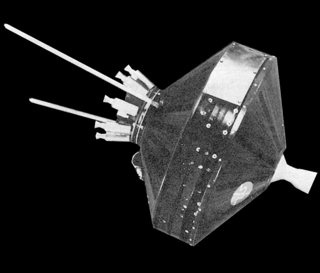
Pioneer 0 was a failed United States space probe that was designed to go into orbit around the Moon, carrying a television camera, a micrometeorite detector and a magnetometer. It was part of the first International Geophysical Year (IGY) science payload. It was designed and operated by the Air Force Ballistic Missile Division as the first spacecraft in the Pioneer program and was the first attempted launch beyond Earth orbit by any country, but the rocket failed shortly after launch. The probe was intended to be called Pioneer, but the launch failure precluded that name.

Pioneer 2 was the last of the three project Able space probes designed to probe lunar and cislunar space. The launch took place at 07:30:21 GMT on 8 November 1958. After Pioneer 1 had failed due to guidance system deficiencies, the guidance system was modified with a Doppler command system to ensure more accurate commands and minimize trajectory errors. Once again, the first and second stage portion of the flight was uneventful, but the third stage of the launch vehicle failed to ignite, making it impossible for Pioneer 2 to achieve orbital velocity. An attempt to fire the vernier engines on the probe was unsuccessful and the spacecraft attained a maximum altitude of 1,550 km (960 mi) before reentering Earth's atmosphere at 28.7° N, 1.9° E over NW Africa. A small amount of data was obtained during the short flight, including evidence that the equatorial region around Earth has higher flux and higher energy radiation than previously considered and that the micrometeorite density is higher around Earth than in space. The reason for the third stage failure was unclear, but it was suspected that the firing command from the second stage, which contained the guidance package for the entire launch vehicle, was never received, possibly due to damage to electrical lines during staging.

Pioneer 1 was an American space probe, the first under the auspices of NASA, which was launched by a Thor-Able rocket on 11 October 1958. It was intended to orbit the Moon and make scientific measurements, but due to a guidance error failed to achieve lunar orbit and was ultimately destroyed upon reentering Earth's atmosphere. The flight, which lasted 43 hours and reached an apogee of 113,800 km, was the second and most successful of the three Thor-Able space probes.

Luna 1, also known as Mechta, E-1 No.4 and First Lunar Rover, was the first spacecraft to reach the vicinity of Earth's Moon, the first spacecraft to leave Earth's orbit, and the first to be placed in heliocentric orbit. Intended as a Moon impactor, Luna 1 was launched as part of the Soviet Luna programme in 1959.

Pioneer P-30 was intended to be a lunar orbiter probe, but the mission failed shortly after launch on September 25, 1960. The objectives were to place a highly instrumented probe in lunar orbit, to investigate the environment between the Earth and Moon, and to develop technology for controlling and maneuvering spacecraft from Earth. It was equipped to estimate the Moon's mass and topography of the poles, record the distribution and velocity of micrometeorites, and study radiation, magnetic fields, and low frequency electromagnetic waves in space. A mid-course propulsion system and injection rocket would have been the first United States self-contained propulsion system capable of operation many months after launch at great distances from Earth and the first U.S. tests of maneuvering a satellite in space.

Pioneer P-31 was intended to be a lunar orbiter probe, but the mission failed shortly after launch. The objectives were to place a highly instrumented probe in lunar orbit, to investigate the environment between the Earth and Moon, and to develop technology for controlling and maneuvering spacecraft from Earth. It was equipped to take images of the lunar surface with a television-like system, estimate the Moon's mass and topography of the poles, record the distribution and velocity of micrometeorites, and study radiation, magnetic fields, and low frequency electromagnetic waves in space. A midcourse propulsion system and injection rocket would have been the first United States self-contained propulsion system capable of operation many months after launch at great distances from Earth and the first U.S. tests of maneuvering a satellite in space.

Mars 1, also known as 1962 Beta Nu 1, Mars 2MV-4 and Sputnik 23, was an automatic interplanetary station launched in the direction of Mars on November 1, 1962, the first of the Soviet Mars probe program, with the intent of flying by the planet at a distance of about 11,000 km (6,800 mi). It was designed to image the surface and send back data on cosmic radiation, micrometeoroid impacts and Mars' magnetic field, radiation environment, atmospheric structure, and possible organic compounds.

Pioneer 5 was a spin-stabilized space probe in the NASA Pioneer program used to investigate interplanetary space between the orbits of Earth and Venus. It was launched on 11 March 1960 from Cape Canaveral Air Force Station Launch Complex 17A at 13:00:00 UTC with an on-orbit dry mass of 43 kilograms (95 lb). It was a 0.66 metres diameter sphere with 1.4 metres span across its four solar panels and achieved a solar orbit of 0.806 × 0.995 AU.
A solar thermal rocket is a theoretical spacecraft propulsion system that would make use of solar power to directly heat reaction mass, and therefore would not require an electrical generator, like most other forms of solar-powered propulsion do. The rocket would only have to carry the means of capturing solar energy, such as concentrators and mirrors. The heated propellant would be fed through a conventional rocket nozzle to produce thrust. Its engine thrust would be directly related to the surface area of the solar collector and to the local intensity of the solar radiation.

A CubeSat is a class of miniaturized satellite with a form factor of 10 cm (3.9 in) cubes. CubeSats have a mass of no more than 2 kg (4.4 lb) per unit, and often use commercial off-the-shelf (COTS) components for their electronics and structure. CubeSats are put into orbit by deployers on the International Space Station, or launched as secondary payloads on a launch vehicle. As of August 2021, more than 1,600 CubeSats have been launched.
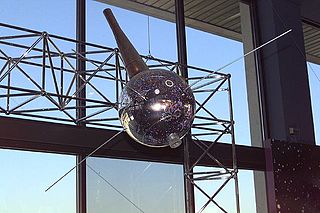
Vanguard 3 is a scientific satellite that was launched into Earth orbit by the Vanguard SLV-7 on 18 September 1959, the third successful Vanguard launch out of eleven attempts. Vanguard rocket: Vanguard Satellite Launch Vehicle-7 (SLV-7) was an unused Vanguard TV-4BU rocket, updated to the final production Satellite Launch Vehicle (SLV).
Explorer 2 was an American unmanned space mission within the Explorer program. Intended to be a repetition of the previous Explorer 1 mission, which placed a satellite into medium Earth orbit, the spacecraft was unable to reach orbit due to a failure in the launch vehicle during launch.
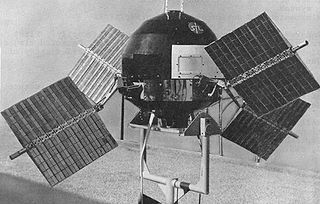
Explorer 6, or S-2, was a NASA satellite, launched on 7 August 1959, at 14:24:20 GMT. It was a small, spheroidal satellite designed to study trapped radiation of various energies, galactic cosmic rays, geomagnetism, radio propagation in the upper atmosphere, and the flux of micrometeorites. It also tested a scanning device designed for photographing the Earth's cloud cover. On 14 August 1959, Explorer 6 took the first photos of Earth from a satellite.

A Moon landing or lunar landing is the arrival of a spacecraft on the surface of the Moon. This includes both crewed and robotic missions. The first human-made object to touch the Moon was the Soviet Union's Luna 2, on 13 September 1959.
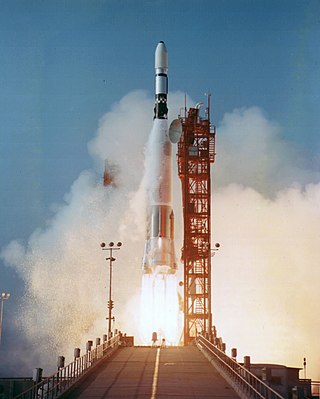
The Atlas-Agena was an American expendable launch system derived from the SM-65 Atlas missile. It was a member of the Atlas family of rockets, and was launched 109 times between 1960 and 1978. It was used to launch the first five Mariner uncrewed probes to the planets Venus and Mars, and the Ranger and Lunar Orbiter uncrewed probes to the Moon. The upper stage was also used as an uncrewed orbital target vehicle for the Gemini crewed spacecraft to practice rendezvous and docking. However, the launch vehicle family was originally developed for the Air Force and most of its launches were classified DoD payloads.
Manfred Memorial Moon Mission (4M) was the first private lunar probe to successfully fly by the Moon. It was led by LuxSpace, a child company of German OHB System, and named in honor of OHB Systems founder, Manfred Fuchs, who died in 2014. It was launched with the Chinese Chang'e 5-T1 test spacecraft on 23 October 2014. The lunar flyby took place on 28 October 2014, after which the spacecraft entered elliptical Earth orbit and continued transmission until 11 November 2014, exceeding its designed lifetime by four times.
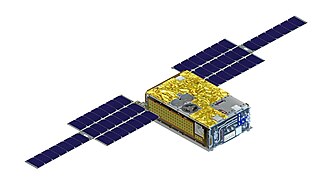
EQUULEUS is a nanosatellite of the 6U CubeSat format that will measure the distribution of plasma that surrounds the Earth (plasmasphere) to help scientists understand the radiation environment in that region. It will also demonstrate low-thrust trajectory control techniques, such as multiple lunar flybys, within the Earth-Moon region using water steam as propellant. The spacecraft was designed and developed jointly by the Japan Aerospace Exploration Agency (JAXA) and the University of Tokyo.
Lunar Trailblazer is a planned small lunar orbiter, part of NASA's SIMPLEx program, that will detect and map water on the lunar surface to determine how its form, abundance, and location relate to geology. Its mission is to aid in the understanding of lunar water and the Moon's water cycle. Lunar Trailblazer is currently slated to launch in early 2024 as a secondary payload on the IM-2 mission. The Principal Investigator (PI) of the mission is Bethany Ehlmann, a professor at Caltech.
